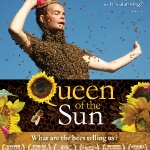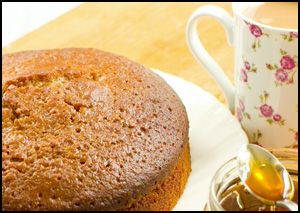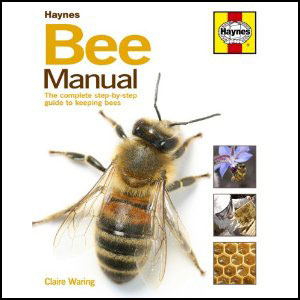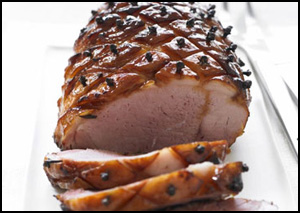Spring should now be making an appearance, with some warmer days when bees can forage a little more freely. Crocus are just beginning to show (mid-February) and pussy willows will start to flower in March; it is the male pussy willow that is of most benefit to the bees, yielding prodigious amounts of pollen and nectar at a time when little else is on offer (the female catkins offer nectar alone, so although of benefit to the bees, are visited less frequently). Hives situated near to these trees always seem to do well, just so long as the weather is not too unkind. Bumblebee queens (at least those species that emerge from hibernation earlier in the year) can also be seen collecting pollen and nectar prior to colony initiation – they need to consume the pollen for their ovaries to mature, which then stimulates them to go ‘house-hunting’ – you can see them hovering low over the ground looking for a suitable site – south facing banks or thick, tussocky grass are favourites.
Brood rearing will now be going on apace, with the queen re-laying cells as they become vacant as well as extending the total area of brood as the cluster grows in size. The bees’ need for water will now increase – some of this will be licked up from cold surfaces in the hive but by far the majority needs to be brought in from outside. If there is no nearby source, or their chosen watering-hole might cause conflict with your neighbours, then place a tray of moist peat in a warm, sheltered spot in the garden/apiary, but do remember to keep it moist as once bees have found an alternative water supply, it is very difficult to change their minds.
It is a good idea to get the bees onto a clean floor at this time of the year – just quietly lift the whole hive to one side, set a clean floor in its place, then separate the broodbox from the old floor and replace on the clean one. Take the old floor away, scrape it clean, then scrub it with warm, soapy water. Leave it to dry, and then go over it with a blow torch (don’t flame epoxy-coated mesh though!). This treatment should help to control diseases in the hive. You can also transfer the bees to a fresh broodbox at the same time, scraping the old one clean and going over it with a blow torch as before, with the same benefit.
On a mild day you should make a point of looking at the activity at the hive entrance – a colony whose foragers are returning with large loads of pollen has probably come through the winter fine, even if the number of foragers varies from one hive to another, but a hive with few foragers and almost no pollen coming in needs to be checked, but keep any necessary inspections as brief as possible (I would not carry out full inspections on obviously healthy hives until later this month, and then only if the weather is warm.)
Smoke the bees a little if they need it, then gently remove an unoccupied outside frame. Look down between the frames to ascertain where the cluster is, and gently part the frames in the middle; now remove a central frame and check to see if there is brood present, especially eggs. If you cannot see either, then the colony has probably lost its queen, and should be united with a queenright colony that seems to be short of flying bees. Do this by placing a sheet of newspaper on the queenright hive, held in place by a queen excluder, and placing the queenless lot on top (the excluder is there to hold the paper in place and to act as a sieve just in case there is a queen present in the top lot – I have known the occasional hive to have a queen who functioned quite normally except that she stopped laying altogether!) If the removed frame contains drone brood instead of the expected worker, but it is in a fairly compact mass, then the queen has probably run out of sperm, and although laying normally, cannot produce fertile eggs. The drone cells are easily recognised by their raised cappings. If the bees are fairly quiet, then go through them until you find the queen, kill her and then unite them to another colony as before.
If, however, you find scattered drone brood, and can see occasional cells containing more than one egg, then the queen has died some time ago and some of the workers’ ovaries have developed sufficiently to enable them to lay eggs. The best solution in this instance is to take the hive some distance away and then shake all the bees onto the ground, leaving them to work out their own salvation.
With any attempts at uniting bees, you must be reasonably sure that the colonies are healthy, otherwise you run the risk of spreading disease through your apiary; also, try not to add bees from a stock that swarms annually to one that swarms infrequently as they may cause the latter to swarm when they might have gone through the season without doing so. If a hive goes queenless at the very end of the month, and is quite strong, you may well want to try and save it by introducing a queen. Unfortunately, home-bred queens are a bit thin on the ground at this time of the year, but try asking members of your association if they know of any.
Whilst you are in the apiary, I would heft each hive; any that feel light can now be fed a gallon of syrup in a contact feeder – it is important that you use this type of feeder in the spring as with other types the bees need to leave the cluster to gain access to the syrup, and during a cold spell they won’t and may die inches from the food. You can, of course, still feed candy if that is easier.
During the second half of the month, you will probably find occasional colonies that have expanded to the point of needing a super; any colony that occupies 2/3 or more of the broodbox should be given a super above an excluder – if you are worried that the extra space will be too much for them to cope with, then put the super above a sheet of newspaper, which they will chew through when they require more space. This method is especially useful if you might not be able to visit the hives for a few weeks; several supers can be put on at one time, each separated by a sheet of newspaper.
If you think that your bees may have a higher level of varroa infestation than you would like, then now is a good time to treat –I would use Apiguard (thymol based) or Api Life Var as the mites in this area are now showing signs of resistance to pyrethroids. Always read the instructions first, though.





